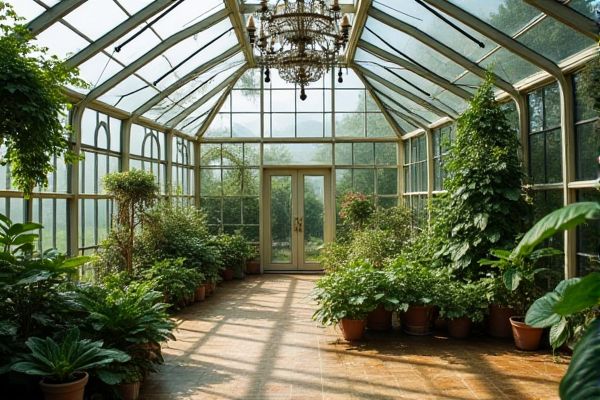
A greenhouse provides a controlled environment with consistent temperature and humidity, ideal for year-round plant growth, while a cold frame relies on passive solar heating and offers limited protection mainly for early planting and frost prevention. Learn more about the pros and cons of each to decide which option best suits your gardening needs.
Table of Comparison
| Feature | Greenhouse | Cold Frame |
|---|---|---|
| Structure | Fully enclosed building with transparent walls and roof | Low, box-like frame with a transparent top |
| Temperature Control | Advanced control with heaters, vents, and fans | Passive solar heating, limited temperature regulation |
| Usage | Year-round growing of diverse plants | Extending growing season, hardening plants |
| Size | Large to extra-large structures | Small, compact size |
| Cost | High initial investment and maintenance | Low cost and minimal maintenance |
| Mobility | Stationary | Often portable or movable |
| Protection | Strong protection against weather and pests | Moderate protection from cold and pests |
Introduction to Greenhouses and Cold Frames
Greenhouses provide controlled environments with transparent walls and roofs, enabling year-round cultivation by regulating temperature, humidity, and light for optimal plant growth. Cold frames are smaller, low-profile structures typically made with a hinged glass or plastic cover that trap solar heat, extending the growing season by protecting plants from frost and cold weather. Both tools enhance gardening efficiency, but greenhouses offer more extensive climate control compared to the passive heat retention of cold frames.
Key Differences Between Greenhouses and Cold Frames
Greenhouses provide a fully enclosed, controlled environment with transparent walls and roofs that maximize sunlight exposure and allow regulation of temperature, humidity, and ventilation. Cold frames are simpler structures, typically low-profile boxes with a transparent lid, designed to trap solar energy and protect plants from cold weather without extensive climate control. The key difference lies in greenhouses' ability to support year-round growing conditions, while cold frames mainly extend the growing season by offering frost protection and moderate warmth.
Structural Design and Materials
Greenhouses typically feature larger, more robust structures made from aluminum or steel frames with glass or polycarbonate panels to maximize light transmission and durability. Cold frames are smaller, low-profile constructions often made with wooden frames and clear plastic or glass lids designed to trap heat close to the ground for seedling protection. The structural design of greenhouses supports extensive plant growth and environmental control, while cold frames offer a simple, portable solution for early season gardening.
Temperature Control and Insulation
Greenhouses provide superior temperature control with integrated heating systems and vents that regulate airflow, maintaining stable conditions ideal for year-round plant growth. Cold frames rely heavily on passive solar heating and insulation from transparent lids, offering less precise temperature management but effective protection against frost. Insulation in greenhouses is enhanced by double-glazed panels or polycarbonate sheets, whereas cold frames typically use simple glass or plastic covers that retain heat primarily during sunny days.
Cost and Installation Considerations
Cold frames typically have lower initial costs and simpler installation processes, making them accessible for gardeners with limited budgets and space. Greenhouses involve higher upfront investment due to materials like glass or polycarbonate and may require professional assembly and foundation work. Maintenance expenses also tend to be greater for greenhouses because of heating, ventilation, and structural upkeep requirements.
Ideal Plants for Greenhouses vs Cold Frames
Greenhouses provide a controlled environment ideal for tropical plants, orchids, tomatoes, and peppers that require consistent warmth and humidity year-round. Cold frames suit hardy vegetables like lettuce, spinach, and kale, which tolerate cooler temperatures and benefit from early-season protection. Your choice depends on the plant's temperature needs and the growing season you aim to extend.
Season Extension Capabilities
Greenhouses offer superior season extension capabilities by providing controlled environments with regulated temperature, humidity, and light, enabling year-round cultivation of a wide variety of plants. Cold frames extend growing seasons primarily by protecting plants from frost and retaining solar heat, but their effectiveness is limited during extreme cold or low light conditions. For maximum season extension, greenhouses support advanced heating and ventilation systems, whereas cold frames serve as passive solar heat traps suited for shorter-term protection.
Space, Size, and Scalability
Greenhouses offer larger space and greater scalability, allowing for the cultivation of a wide variety of plants and the use of automated systems, while cold frames occupy smaller footprints ideal for compact gardens or patios. The size of greenhouses ranges from small hobby models to expansive commercial structures, making them suitable for extensive growing seasons and larger-scale operations. Cold frames are typically low-profile, portable units optimized for early seed starting or hardening off plants, providing flexibility for gardeners with limited space.
Maintenance and Durability
Greenhouses generally require more regular maintenance, including cleaning, ventilation system checks, and repairs due to their complex structures and mechanical parts, but they offer enhanced durability with robust materials like aluminum and polycarbonate. Cold frames are low-maintenance, often needing only seasonal cleanup and occasional repair of wooden or plastic covers, but they are less durable and susceptible to weather damage compared to greenhouses. The choice between the two depends on the balance between desired durability and acceptable maintenance levels for extended plant protection.
Choosing the Right Option for Your Garden
Greenhouses provide controlled environments with temperature regulation, ideal for year-round cultivation and protecting delicate plants from extreme weather, while cold frames rely on passive solar heat, offering a cost-effective solution for extending the growing season. Consider garden size, budget, and the types of plants you wish to grow when deciding between the two; greenhouses suit larger, more intensive gardening projects, whereas cold frames are perfect for small-scale, seasonal protection. Understanding these distinctions ensures optimal plant growth and efficient resource use tailored to your gardening goals.
 homyna.com
homyna.com